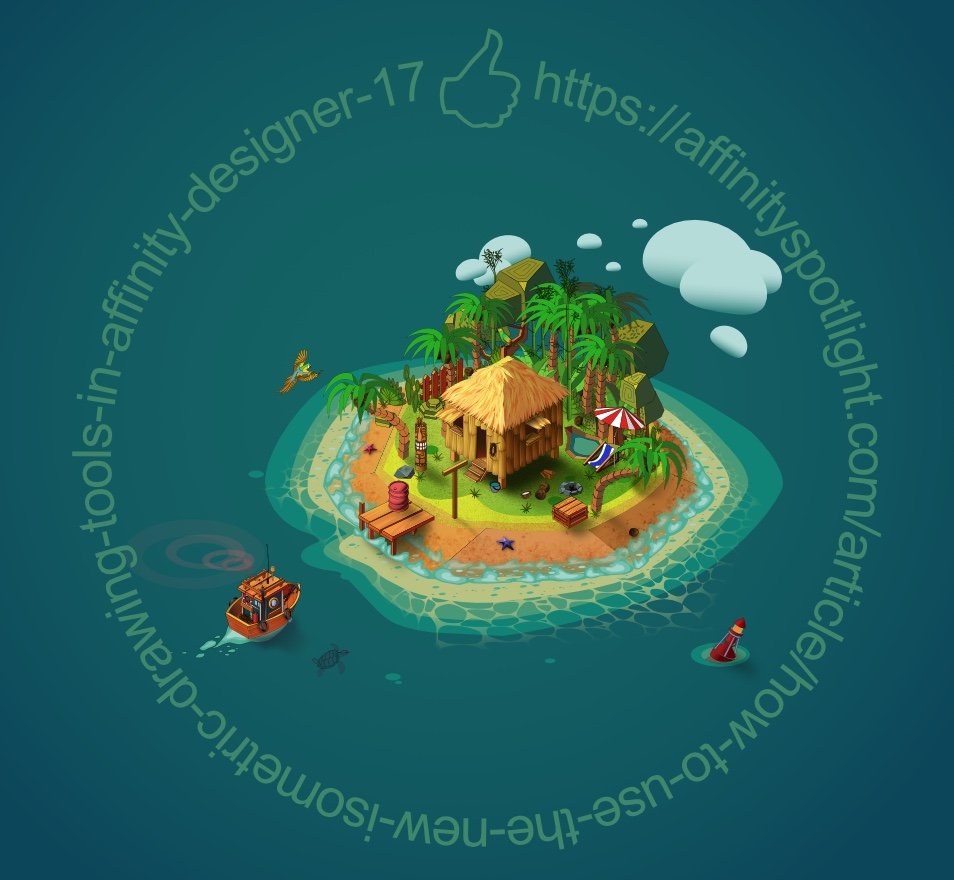The new Affinity Designer 1.7 update gives us all a MASSIVE set of new features and improvements that are quite simply impossible to detail all in a single post. So, to keep our heads from exploding into tiny pixels, we are going to focus exclusively on the new isometric drawing tools and break them down as smoothly as possible. The result being, that by the end of this tutorial, you’ll be able to create your own organic isometric assets like a pro.
You can get all the assets I created for this tutorial using the download button below.
Tip: You can learn to how to install Assets in Affinity Designer in our guide to installing creative resources.1. Setting up the Isometric Grid
Affinity Designer’s 1.7 update, adds new options to the Grid and Axis Manager Panel. However, for this tutorial, we’re going to focus exclusively on the Isometric Grid settings. You can see a quick overview in this video:

Affinity Designer makes use of highly customisable isometric and other axonometric grids, perfect for UI/game design, digital design models, mock ups or designs which benefit from this style. Isometric drawing and grid. About isometric and axonometric grids Isometric and other axonometric grids are, by nature, parallel projections. Isometric drawing in Affinity Designer 1 7. Illustrator 229 Tienda desierto con rejilla isometrica. This is the other side of the spectrum, good ol isometric vectors It became part of a larger infographic that a colleague of mine finished (and which I cant share at the moment).
- Download All 37 “isometric” graphics compatible with Affinity Designer unlimited times with a single Envato Elements subscription. Our site is great except that we don‘t support your browser. Try the latest version of Chrome, Firefox, Edge or Safari.
- Create Isometric Text with Affinity Designer Using The Isometric Tool. Why Merging Layers In Affinity Designer Is So Complicated.
2. Getting to know the NEW Isometric Panel
This is a huge one. This panel is going to basically save you tons of steps by projecting your shapes into isometric planes automatically.
Affinity Designer Isometric Grid Ipad
Let’s see how it works:
3. Stepping up the game
So, you’re thinking making simple geometry like isometric buildings and cityscapes is now almost too easy using Affinity Designer? Well, let’s challenge ourselves then. How about crossing (just a little bit) the boundaries between 3D and 2D art?
One style of 3D art that I LOVE is so-called low-poly art. Before Affinity Designer 1.7, creating this type of art was totally feasible but was really time-consuming since you needed to perform more calculations using the Transform Panel.
Let’s make some happy trees.
Having the tools to manipulate shapes more efficiently allows us more creative licenseto draw our shapes.
Tip: Learn more about mixing vector and raster graphics in this tutorial.As you can see, just by following this simple technique shown in the image above, you can come up with many shapes to combine together and create a nice collection of reusable isometric assets for your projects.
 Tip: Avoid using RIGHT angles (90°) when drawing your planes, to make your objects look more organic and stylised.
Tip: Avoid using RIGHT angles (90°) when drawing your planes, to make your objects look more organic and stylised.4. Create anything you can imagine.
All of the assets for this tutorial have been made in the same way. The Isometric Panel is both, a time saver and a creativity booster since it helps you to focus more on your artwork creatively and less on the technical aspects.
Remember, you aren’t limited to just 4-sided faces, to add complexity to your shapes, you can draw multiple-side polygons (1). The more sides you add, the less rigid your assets will look when projected (2).
The process of creating the top and bottom planes (3) and then, connecting the dots to draw faces (4), remains the same.
5. Using textures.
To give some character and depth to your isometric objects, you can use the techniques shown in THIS TUTORIAL we made a while ago, explaining in detail how to add raster textures to vector shapes in Affinity Designer.
Affinity Designer Isometric
6. Time to play!
Once you’ve created some individual isometric assets, you can arrange them and make quick compositions to test what works best for your scene. These new features in Affinity Designer 1.7, will allow you to build more intricate illustrations in half the time.
Affinity Isometric Studio
Visit Frankentoon’s TOON LAB for more Affinity Designer tutorials covering a range of techniques from quick complex masking and painting with textures, to emulating retro graphics and comic book illustration.

This tutorial is aimed at desktop users of Affinity Designer 1.7, though its worth noting that Affinity Designer on iPad has also had isometric features added in our 1.7 update!
